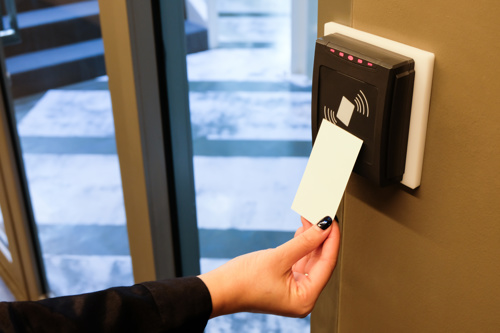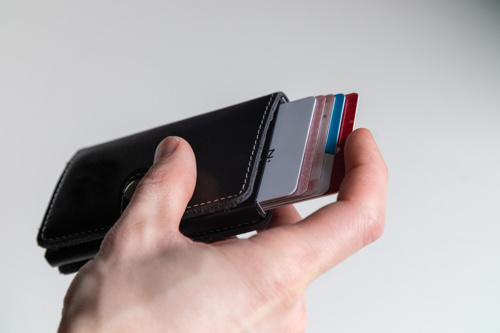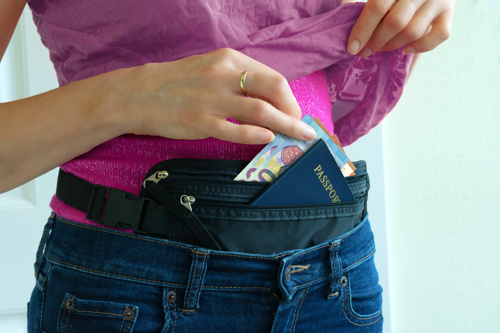-
Our Christmas opening hours may vary - please check your local branch hours before you visit.
RFID blocking is a feature that prevents criminals from accessing information stored on RFID-enabled items like credit and debit cards. These contain Radio Frequency Identification tags – shortened to RFID – which make contactless payments possible. However, that contactless technology can also leave your sensitive information open to fraudsters, who can steal it at close range using skimming devices.
Things like passports and key fobs can also contain RFID tags, and there are a wealth of RFID-blocking products available that are designed to protect the information stored on them – whether that’s using blocking materials or technology. From money belts to wallets, we’ve taken a closer look at what’s available, as well as the technology involved.
How does RFID blocking technology work?

RFID technology uses radio waves to allow contactless communication between an RFID reader and objects embedded with an RFID tag. These tags contain an antenna which transmits and receives radio waves, and an RFID chip that stores the tag’s information.
In banking, many credit and debit cards contain RFID tags to enable contactless payments – when you pay for something without having to swipe your card or remember your pin. But that means fraudsters can use a card skimmer to read your RFID tag and access your information, even if your card is protected by a layer of clothing or in your wallet.
RFID blocking technology creates a protective shield that prevents the skimming device from accessing the information stored on the RFID tag. The shield blocks the radio waves used to communicate between the tag and the card skimmer. As a result, the RFID blocking technology effectively disrupts the signal, making it unreadable.
How does RFID blocking technology help protect your money?
While it’s a relatively uncommon crime these days, RFID skimming fraud is more likely to happen when you’re in a busy, crowded place – like an airport or train station. The reason being, criminals need to get pretty close to you in order to scan your card fraudulently, similar to the way you would need to put your credit or debit card right up against a card reader in order to pay.
The busier the location, and the more preoccupied you are, the less likely you are to notice someone in very close proximity to you. Although the risk of RFID skimming is reducing all the time thanks to improved encryption techniques, RFID blocking technology can help to prevent your sensitive financial information from being compromised by scrambling the signals from skimming machines, protecting your money in the process and giving you peace of mind.
What RFID devices are available?
If you’re concerned about RFID skimming scams – for example, if it’s a known risk in the destination you’re heading to – you’ll find a whole range of wearable travel products offering built-in RFID protection. At one point there was even a pair of RFID-blocking jeans developed to prevent digital pick-pocketing, although most travellers tend to stick to wallets, cards and money belts.
Some RFID devices feature a physical metal barrier – like carbon fiber and aluminum, for example – to absorb or deflect signals. This is known as passive RFID blocking. Others use RFID-blocking technology, where a microchip interferes with signals, which is known as active RFID blocking.
What is an RFID protected wallet?

An RFID protected wallet has built-in RFID blocking materials to protect your cards and passport from skimming devices. The wallet creates a protective barrier that prevents the radio waves emitted by the RFID tags from being read by a card skimmer or similar device.
What is an RFID money belt?

Just like an RFID wallet, an RFID money belt or bum bag has RFID blocking materials embedded in it – whether that’s just an internal card sleeve, or the whole bag. As this wearable pouch is worn around your waist, it’s hands-free and provides a secure way to store your credit and debit cards, travel money and passport. Just bear in mind that while RFID money belts protect you from contactless fraud, you’ll still need to be vigilant for pickpocketing or theft.
What is an RFID blocking card?
An RFID-blocking card looks like a standard credit or debit card, but it’s fitted with a chip and antenna designed to scramble and block incoming RFID or NFC signals. These cards don’t need charging and can simply be placed in your normal wallet alongside your credit and debit cards.
Do RFID blocking wallets damage my cards?
RFID blocking wallets won’t damage your cards or any other items containing an RFID tag. The RFID blocking technology within the wallet doesn’t come into contact with the card, so the blocking material doesn’t interfere with the functioning of the RFID tag. Just bear in mind that if your RFID blocking wallet becomes damaged, it can become less effective at blocking radio waves and open you up to contactless fraud.
How else can I minimise the risk?
While credit and debit cards are increasingly equipped with built-in security measures to protect them against RFID theft at close range, card skimming is also a risk at ATM machines – where criminals fit concealed devices to the cash point to steal your information. Take Five to Stop Fraud has some good advice on common ATM scams and what to look out for, but you can minimise the risk when travelling by exchanging foreign currency in cash before you go. That way you can avoid the need to use unfamiliar ATM machines at all during your trip, as well as the card fees that come with it. Take a look at our guide to travelling with cash for more tips and advice, as well as how to keep money safe when travelling abroad.
Buying Travel Money with M&S
Getting ready for your trip? Order your Travel Money with M&S online today for Click & Collect with no commission and no hidden fees. T&Cs apply.
